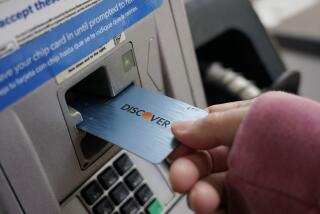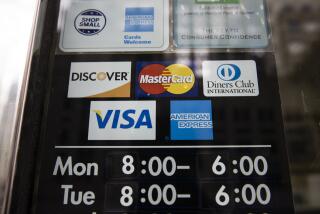Overdraft protection fees can pile up fast
Don Wright, 65, didn’t know he was enrolled in his bank’s overdraft protection plan until he overdrew his checking account by 85 cents. The transaction triggered snowballing fees that ultimately added up to more than $120.
Now people like Wright are at the heart of proposed banking rules that would allow customers to avoid overdraft programs that some maintain have become a racket.
“They [banks] say they’re covering your transaction as a courtesy,” said Wright, a self-employed businessman from Dayton, Ohio. “But they’re making a killing. I don’t want them to approve a debit when I don’t have enough to cover it in my account. This is a complete fraud.”
The Federal Reserve, which sets some banking rules, has been weighing new regulations for overdrafts for more than a year. They’re giving consumers the ability to comment until the end of March, with the anticipation that they’ll come out with final rules by this summer.
The rules are necessary, experts contend, because most banks now automatically enroll checking account customers in overdraft plans -- and some banks won’t let them out. Bank of America, for example, doesn’t give consumers the option of dropping overdraft protection, a company spokeswoman says. If you have a checking account with the bank, you have it. Period.
And the programs aren’t exactly cheap. Banks typically charge between $25 and $35 per overdraft. Many impose additional fees for each day the consumer maintains a negative balance. The fees are equally high whether you’re overdrawn by hundreds of dollars, or just a few pennies, like Wright.
That’s got consumer groups up in arms.
“These are high-cost loans that cost consumers billions of dollars every year,” said Lauren Zeichner Bowne, staff attorney for Consumers Union in San Francisco. “The Federal Reserve Board should protect consumers by stopping the fees unless the consumer makes the choice to opt in to the program.”
Bankers counter that overdrafts are easy to avoid. Consumers simply need to keep better track of their account balances, said Nessa Feddis, vice president and senior counsel at the American Bankers Assn.
Or, if consumers prefer, they can link a savings account or a credit card to their checking account, ensuring that any overdraft hits the linked account rather than the overdraft program. These programs are also pretty pricey; banks charge a fee of $3 to $5 per overdraft, and also bill any linked credit cards at the cash-advance rate, which can be quite high. Still, unless you let the balance linger on the card, that’s generally cheaper than the $35 a pop charged for uncovered overdrafts.
A report by the Center for Responsible Lending said that a number of bank policies make it tough for consumers to keep good track of their balances. As a result, fees for overdrafts have soared to an estimated $7.8 billion annually.
For example, if you use a debit card at a gas station it’s likely that the station will put a hold of $50 to $75 on your bank account, even if your total charge was only $10 or $20, the report said. If you’re unaware of the hold, as many consumers would be, you could proceed to use your debit card for a $2 soda, a $3 snack and a $5 lunch -- all of which would be easily covered by the money that’s left in your account -- but still face $105 in overdraft fees as a result of the hold.
Then, too, banks increasingly change the order in which they process incoming checks when debiting your account. Typically, they subtract big checks (and debits) before small ones, even if the small items come in first. The banks argue that this, too, is a courtesy because big checks are often for important payments, such as the mortgage or rent, and could have serious repercussions if bounced.
Consumer groups suspect a more practical motive: If checks were paid in order, it could result in far fewer overdraft fees. Consider a consumer who had a $100 balance, and wrote 10 checks (or used her debt card 10 times) for small items that added up to $40, then wrote a $100 check that caused an overdraft. If the transactions were processed in order, the consumer would get hit with one $35 fee, when the $100 check was presented. But, if the bank changed the order, subtracting the $100 first, the consumer would get hit with $350 in fees -- $35 for each of those 10 little charges.
The Federal Reserve doesn’t plan to dictate debit order, nor to rule on whether “holds” can trigger overdraft fees. At the moment, the agency’s proposed rules deal with just one issue: Should consumers be allowed to opt in to overdraft programs, or can banks automatically enroll them unless they opt out?
Banks want the Federal Reserve to simply let consumers opt out, if they want to. That comes closest to preserving the status quo.
Consumers Union and the Center for Responsible Lending argue that it’s important that consumers opt in, so they must affirmatively choose the program and understand its terms before they are subjected to the fees.
Either result is an improvement, Bowne acknowledges. Right now, consumers are enrolled in the programs, often without disclosure and often without the ability to get out. The Federal Reserve has floated two draft proposals, and both demand disclosure and the ability for consumers to exit the overdraft program.
Still, the proposals are only drafts and could be revised before they’re finalized. That’s why consumer groups are urging bank customers to tell the Federal Reserve their horror stories and lobby for choice. Both Consumers Union and the Center for Responsible Lending are making the process simpler by providing comment forms on their websites.
“The Fed really listens to individuals,” Bowne said.
“When they were looking at credit card legislation, they got record numbers of comments from individuals, and that made a big difference to what they decided. We’re hoping that the same thing will happen here.”
--
kathykristof24@gmail.com
More to Read
Inside the business of entertainment
The Wide Shot brings you news, analysis and insights on everything from streaming wars to production — and what it all means for the future.
You may occasionally receive promotional content from the Los Angeles Times.










